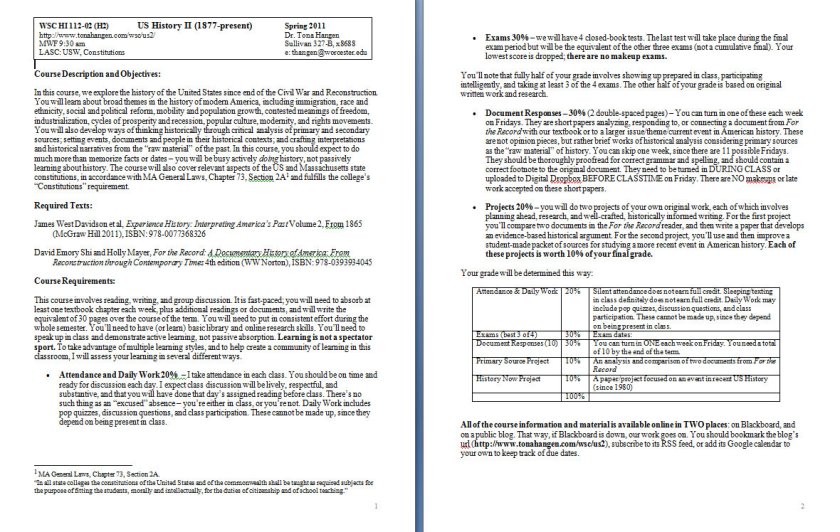Hey everyone,
Now that the semester is finally over, it is time for me to start getting serious about my qualification exams. They are officially one month away (June 20th) and I’m starting to feel the pressure.
Harvard OEB quals are a bit unusual. You don’t have any written exams. What you do have, however, is a 3-hour long oral exam. In preparation for that exam, you write a 10-ish page thesis proposal, a 20-min presentation on said proposal, and three course syllabi. Now, the proposal and presentation make sense at first glance, but what about the syllabi?
Between the three syllabi, you have two broader, more general courses and one more specific (maybe grad-level) course. And they are each organized into 12-week schedules, each week with two or three meeting periods, and each meeting period or topic has 2-4 book chapters or research articles associated with it. By creating these syllabi and turning them in, you are saying to your committee that you feel well-versed enough in the material you cover in the course to be able to teach about that topic. Here are all the chapters and papers you’ve read and are familiar with, with regards to each topic. AMA.
Sounds fun, right???
And of course, the three courses should be related to your work. I chose to do Ichthyology, Comparative Biomechanics, and Bio-Inspired Design. The first two are a bit more general, sophomore/junior level and rely heavily on textbooks. The third class is basically all primary research literature.
At this point, two weeks into my quals prep, my syllabi are made and out for edits with my committee, and I love them.
Going through school, I was always the kid that looked forward to reading the syllabus for a class. (I know, nerd much?) I would go through and transfer meaningful dates to my calendar and read about projects and papers and learn what was expected of me. I always liked knowing what I was getting into. And you can also learn about the professor through their syllabi, as well. Tone is important, word choices here and there let you know if they’re going to be super strict and uptight or more relaxed and perhaps a bit more fun.
That being said, very rarely did I enjoy looking at syllabi. They look like technical manuals, most of the time, and who willingly volunteers to read that stuff? The number of times I’ve heard fellow classmates ask “What is XYZ” to hear “That’s answered in the syllabus” from the professor, or the number of times I’ve heard other TAs and professors rant about all the syllabi-related questions they get tells me that students will go to anybody for answers first before reading that document. Which sucks.
People don’t want to read technical manuals. I always figured that if I made a syllabus, I would make something that people would actually want to read. The first step to getting students to read a syllabus, in my mind, is making them want to look at the page. Students see this and their eyes glaze over:

They don’t read this. They skim it and look for anything unusual, and just read the unusual bits.
Well, quals gave me the perfect opportunity to make the syllabus of my dreams. And I did.

I used Latex, and more specifically Overleaf to create these documents. I found this awesome CV template a while back, Twenty Second CV. I had used the template previously for some lab meetings. (We were talking about influential living and dead scientists related to ichthyology, and we made short summaries of their lives and contributing works, and I did mine in CV form [and others copied me]. This template also let me include pictures of them and talk about their backgrounds and major publications. It was great.)
When I started thinking about how I would format a syllabus, I realized I could easily modify this template to suit my needs.
This is the result. A first page that outlines how I would approach the class and what I’m aiming to do, and the rest of the document is dedicated to the almighty schedule. For a real class, this would obviously need to be modified, as true syllabi need to include a lot more stuff (resources, honor code, absence policy, etc) and the schedule would need to include more information than a topic and the source literature.
I finished these and was so proud of how they turned out that I posted a picture on twitter and tagged Overleaf. Next thing I know, these syllabi are getting a lot of attention from academics. I have not been the only one dreading traditional, conventional syllabi and looking for something better.
People asked that I publish the template and I have: The Inzane Syllabus is availabe for downloading and modifying to suit your own person needs! 🙂
Once quals are over, I plan to go back in and make this tempalte more real-class friendly. It suits my qualification syllabus requirements just fine, but for an everyday class, I know it’ll need work. So sometime in July I’ll upload the new version. But until then, I’m am just so flattered that people want to use this template as is.
At this point, I’m busy working on my thesis proposal. I’m three chapters done, and starting to work on the fourth! Hopefully I’ll have that wrapped up by the end of the week and can start reading all the papers I put in my syllabus, haha.
Also at some point, I’m going to post about my first semester teaching. It was definitely a learning curve, and I want to share my experiences and reflect upon what I can improve and do differently.
Until then, stay frosty!
Cheers,
Z




Wow, nice syllabi. Way to go
Sent from my iPhone
>
LikeLike